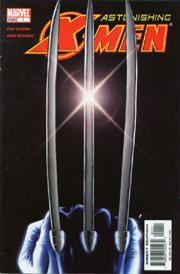|
Homepage > Joss Whedon Crew > Joss Whedon > Reviews > Joss Whedon - "Astonishing X-Men" Comic Book - Issue 01 - Thefourthrail.com (...)
Thefourthrail.com Joss WhedonJoss Whedon - "Astonishing X-Men" Comic Book - Issue 01 - Thefourthrail.com ReviewDon MacPherson Saturday 29 May 2004, by Webmaster
Mildly Recommended (5/10) Marvel Comics Price: $2.99 US/$4.25 CAN I’m not a Joss Whedon fan. Buffy. Angel. Firefly. They did nothing for me. Watching the Buffy TV show was the equivalent of listening to fingernails scratching their way across a blackboard. Don’t ask me why. Still, there’s no denying the man has a major fanbase among genre fans, and I’m pleased that his foray into non-Buffy-related comics brings with it the possibility of luring new readers into this medium. New readers will likely get a kick out of this debut issue as well. It will come off as new, as treating super-heroes as something other than fare for little kids. This book boasts stunning, realistic artwork, lots of action... even some sex. It’s too bad that those of us who read comics regularly have seen it all before. Kitty Pryde returns to the Xavier School for Gifted Youngsters, not as a student, but as a new teacher. But Cyclops has more in mind for the one-time kid sister of the X-Men. Scott Summers has decided the time has come for the X-Men to return to their roots, to act as super-heroes as a means to win public support. And Kitty Pryde, despite her keen mind and amazing powers, is the most human, the most average of all of the X-Men. She’s the veil that’s meant to be drawn over a one-eyed man, a blue-furred man-cat and a bloodthirsty hunter. It’s no surprise that with art by John Cassaday, Astonishing X-Men easily stands out as the most visually compelling of the entire X-Men line. He captures the intensity of Cyclops, Wolverine and Emma Frost incredibly well while Kitty’s youth and enthusiasm helps to balance it out. The two-page Danger Room splash may be a familiar visual, but Cassaday jolts the reader with a larger scope. Mind you, his work here pales in comparison to the realism and imagiantion he brings to the equation in Planetary. That level of passion seems to be lacking here. Furthermore, the apparent use of some computer artwork, though, doesn’t really work for me. A rug in the foyer of the X-Mansion, for example, doesn’t appear as though it belongs with the more traditional linework. In and of itself, this is a decent introduction to the X-Men and a new lineup for the core team. In the greater context of the line of X-Men titles, though, it’s much weaker. Whedon offers another student orientation scene, something we saw twice last week, in New X-Men #1 and X-Men #157. The script doesn’t acknowledge the new statuo quo in Uncanny, or in the adjective-less X-Men. Should the writing on this title be judged by what’s going on in other books? No, I suppose not, but the editing can be. Marvel is marketing the entire X-line as one entity with the "X-Men Reload" brand, encouraging readers to follow mulitple titles. Consistency is called for, but it’s not to be found. The saving grace of this script is Whedon’s incorporation of Kitty Pryde back into the fold. Her casual attitude and sense of returning home are easy to relate to, and she makes the fantastic world of mutants and super-heroes seem more plausible. Kitty is the focus here, so the references to past X-Men continuity tend to revolve around her. New readers won’t pick up on them so easily, though, but longtime X-fans will no doubt eat them up. To be honest, the continuity gaffes alone don’t make for a bad read. Neither does the generic nature of the seemingly new villain introduced in this issue. Where Whedon loses me is with the stilted and implausible speech at the end of the book in which Cyclops says that dressing up in spandex and blowing stuff up as super-heroes is the way to go. Earlier in the script, Whedon reinforces the characters as educators, as people who serve as examples to a younger generation. The "let’s beat up the bad guys, old-fashioned style" suggestion at the end of the issue flies in the face of it. What’s worse is that the speech is treated seriously, and that makes it more laughable. I get what Whedon’s saying here: he’s lauding the fun and simplicity of old-school super-hero storytelling. But he’s doing so in a book that also embraces a more sophisticated tone and emphasis on characterization. It’s a seeming thematic contradition. 3 Forum messages |
